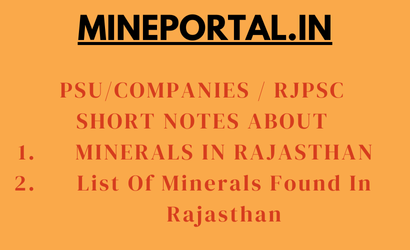
MINERALS IN RAJASTHAN
Minerals In Rajasthan
Any inorganic solid that is found in nature and has a clear chemical composition, as well as an organised internal structure, is referred to as a mineral.
- Rajasthan is the wealthiest State in the nation and produces over 57 distinct minerals. Lead and zinc ores, selenite, and wollastonite are exclusively produced in Rajasthan.
- The State was placed second among the States in 2014–15 and provided roughly 12% of the country's overall mineral output value. It was the sole producer of selenite, wollastonite, lead, zinc concentrates, and more.
Let us learn more about these minerals.
List Of Minerals Found In Rajasthan
Scientists have discovered various types of minerals in Rajasthan. They are discussed in the table below.
|
Mineral |
Details Of Minerals in Rajasthan |
Image |
|
Copper |
|
|
|
Tungsten |
|
|
|
| |
|
Manganese |
|
|
|
| |
|
Gypsum |
|
|
|
Lead-zinc Ore Deposit |
|
|
|
Fluorite
|
|
|
|
Feldspar |
|
|
|
Iron |
|
|
|
Apatite |
|
|
|
Asbestos |
|
|
|
Bauxite |
|
|
|
Beryl |
|
|
|
Potash |
|
|
|
Calcite |
|
|
|
Basalt/ Rhyolite |
|
|
|
Marble |
|
|
|
Granite |
|
|
|
Zinc |
|
|
|
Sandstone |
|
|
Refer to the following table to understand the distribution of minerals in Rajasthan.
|
Minerals available in Rajasthan |
Percentages |
|
Potash |
94% |
|
Lead and zinc ores |
89% |
|
Silver ore |
88%, |
|
Bentonite (75%) |
75% |
|
Wollastonite |
88% |
|
Fuller's earth |
74% |
|
Ochre |
81% |
|
Gypsum |
82% |
|
Marble |
63% |
|
Feldspar |
66% |
|
Copper ore |
54% |
|
Diatomite |
72% |
|
Calcite |
50% |
|
Ball clay |
38% |
|
Talc/soapstone/steatite |
49% |
|
fluorite |
29% |
|
Tungsten |
27% |
Conclusion
The practice of minimising natural resource waste and making sure that the requirements of the present are addressed while taking into account the demands of the future is known as the conservation of natural resources. The modern way of living and technological development have significantly harmed natural resources. Natural resources like coal and oil are depleting quickly, and after they are used up, we will need to turn to alternative energy sources. It is crucial that we humans act in a way that ensures the conservation of natural resources as a result. Similarly, the conservation of minerals in Rajasthan can be practised through recycling and reusing scrap metals























No comments added yet!